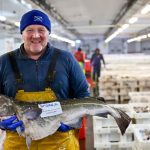A meeting in Copenhagen in mid January may prove to be a breakthrough to a better kind of fisheries science. ICES, the body of international scientists who provide fisheries advice to the European Commission, is undergoing a major reform, part of which is the introduction of “benchmark” meetings that will fundamentally review the quality of fish stock assessments, stock by stock. The idea is for scientists, along with representatives from the fishing industry and independent experts, to analyse how assessments are undertaken, identify any weaknesses and suggest improvements.
The first meeting mainly covered the cod stocks, focusing particularly on North Sea and Celtic sea cod, but also North Sea whiting. Baltic cod was also reviewed. The next meeting, in February, will review some of the key flatfish stocks.
This new approach potentially represents the biggest change in the ICES assessment process since ICES was established. In addition to fishing industry representatives, the meeting was also attended and indeed chaired, by non-ICES fisheries scientists, who peer reviewed the assessments. Over the course of a full week the meeting examined:
The relevance and accuracy of the assessments
How other sources of relevant data, including industry data, could be integrated into the assessments
The inclusion of environmental drivers for stock dynamics
Multi species interactions
Stock identity and migration patterns
Whether the coverage of the assessments is appropriate in terms of space and time
Objectivity and transparency issues.
The NFFO was well represented at the meeting, being part of the North Sea and North West Waters RAC delegations.
The following ways in which the kind of knowledge held by the industry and individual fishermen could be integrated into, or be used to support the assessments, were suggested:
Fisheries Science Projects: The FSP partnership projects, pioneered by the NFFO, Cefas and Defra have subsequently become a model emulated in other European member states. They involve a mix of time series projects and one off projects designed to address a specific question. The collaborative approach has generated scientifically valid data and has built up strong working relationships between fishermen and scientists.
Regional Annual Fisheries Reports: The NFFO and the Cornish Fish Producers’ Organisation have piloted regional AFRs as a way of capturing fishermen’s knowledge and presenting it in a systematic ways that can be useful to both ICES assessment scientists and fisheries managers. Changing technologies, target species and the industry’s reaction to management measures would be key aspects of the reports prepared by regional fisheries organisations with the involvement of their members.
The reinstatement of commercial catch per unit effort data: This valuable source of data was discontinued in the 1990s because of question marks over how representative the data was. It is timely to explore ways of reintroducing CPUE data on a sounder basis.
Interpretation of VMS satellite monitoring data: VMS data which records vessel movements can be a valuable tool but it can also be very misleading if interpreted inaccurately. Industry involvement in interpreting VMS data is a prerequisite for well founded science that understands the meaning beneath the surface observations.
Annual Fishermen’s Survey: The North Sea RAC (and before that the North Sea Commission Fisheries Partnership) has organised an annual survey of fishermen’s experience of stock trends which can be used as a useful check against the ICES assessments.
Reference Fleet: The limitations of ICES annual vessel surveys are well recognised. Repeat tows on a predefined grid, using consistent gear has its value, but unless it is complemented by information from the commercial fleet and fisheries science projects, it can also be very misleading. A reference fleet of commercial vessels with onboard observers could provide a useful check on stock trends and the validity of survey data.
Self Sampling: Potentially, every fishing vessel is a research platform that could provide essential data on catch composition and discard rates that are of critical importance for accurate stock assessments. If adequate incentives can be put in place (to encourage the crews to undertake the extra work involved) self sampling, underpinned by a degree of observer coverage, or even in some circumstances CC TV, can make the difference between a weak and a strong assessment.
Regional Advisory Councils: As well as providing a forum for dialogue between stakeholders and scientists, RACs can disseminate research results to the industry. All this creates a positive context for more positive engagement between fishermen and scientists.
ICES will now consider how these initiatives and others can best be adapted to be of use to the assessment scientists. There is no point in producing data or information that is not in a form in which it can be used.
Cod Biology Research – Tagging
The meeting received presentations on recent research. The work on cod biology using electronic tags was highly revealing of stock identity and migration pathways, including three dimensional movements – vertical movements in the water column – which fishermen have suggested for many years are critically important.
An Opportunity
The benchmark meetings offer a huge opportunity for both fisheries scientists and fishermen to improve the system through which fish stocks are assessed. It would be foolish however, to think that it would be easy to overcome the inertia in the ICES system. There are reformers in the scientific community but there is also an old guard who will resist new ways of doing assessments. The outcome of this power struggle will determine whether we can move forward into a new era of fish stock assessment based on cooperation.








